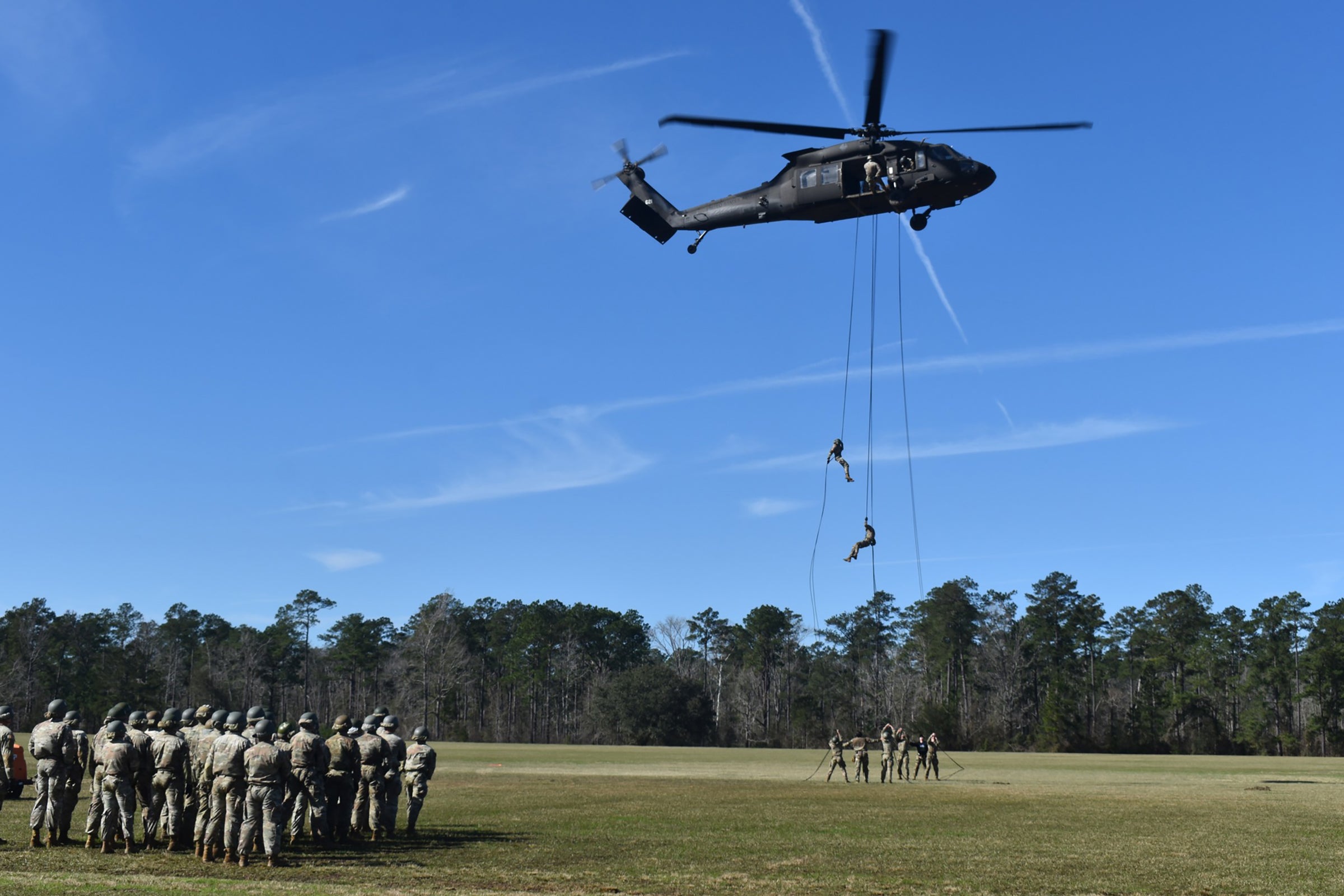Air assault course maximizes soldiers potential in units
Published 6:16 pm Saturday, February 11, 2023

- Air Assault Class 20-23 rappels from a UH-60 Black Hawk helicopter for final fall and rappel test of the course at the Joint Readiness Training Center and Fort Polk's Honor Field.
By Spc. Kelly Aceved | Public Affairs Office
FORT POLK — Every year soldiers at Fort Polk have the opportunity to attend Air Assault School, a strenuous course that pushes them to their limits mentally and physically. The 10-day course is filled with challenges meant to teach Soldiers air assault techniques, sling load operations, and rappelling.
Instructors from Light Fighters School Academy, Fort Drum, oversaw the course and certified the students on graduation day.
The demands began on day zero with layouts (when equipment is laid out in a particular pattern for inventory) and ended with a final 12-mile ruck march. Traditionally, only a few are able to overcome the trials needed to withstand the course and make it to graduation. Certified air assault soldiers can inspect proper loading procedures and use helicopter assets in training or combat environments to support unit operations.
Day zero was Jan. 6. Students conducted layouts expected to match the given packing list down to the finest detail. Candidates who got a “go” on their layout went on to complete a two-mile run and obstacle course. These tests evaluate potential candidates attention to detail and physical fitness.
Candidates who accomplished all three tests were slotted for the course and went on to day one, the start of the actual course.
Although physical fitness plays a huge role, most candidates are dropped during phase two, sling load inspections. Instructor Sgt. Brody Christensen explained how students can make it to graduation.
“Attention to detail is the key to success at Air Assault School. If you can follow directions exactly how the cadre explains, that will help you throughout the course. Students are tested on four different loads and must find deficiencies. That’s where attention to detail comes into play,” he said.
Students who completed sling load operations went on to the fall and rappel drill portion of the course.
The first thing they learned was how to properly and safely make a Swiss seat, a rappel harness made with rope. They were tested on making the Swiss seat in under 60 seconds. Once the Swiss seat is inspected by an instructor, students practiced rappelling from a wall 34 feet high.
The purpose of rappelling off the wall was to show students their belay men could stop them from falling in case they couldn’t stop themselves. This prepared them for four rappel tests, Hollywood rappel, lock-in rappel and combat rappel. The final test included all rappels done without the assistance of a wall to mimic the final rappel off a UH-60 Black Hawk helicopter. Completion of this rappel is a step closer towards graduation.
The day of the final test, the 12-mile ruck march began at 2 a.m. Students who did not complete the ruck in under three hours were dropped from the course, but can attend an air assault course in six months for the ruck march portion of the course.
Upon completion of the ruck march, students were sent home and returned at 10:30 a.m. for their graduation.
Families, peers and leaders of the graduates attended to congratulate them on their achievement.
The top two students were recognized by the instructors. 1st Lt. Jeremy Nguyen as the distinguished honor graduate and 2nd Lt. John Eggers as the honor graduate for Air Assault Class 20-23.
Nguyen said the course gave him tactical and technical proficiency plus attention to detail “I’ll carry those skills with me when checking myself and my Soldiers,” Nguyen said.
For anyone who wants to go air assault, there are a few things you have to do to be successful.
“Come with an open mind, be physically fit and be prepared to learn a lot in a short amount of time,” said Nguyen.
The course is available to all Soldiers regardless of military occupational specialty or rank. Airforce Airmen are also welcome to attend the course.
Christensen had advice for anyone considering to attend the course.
“Brush up on your physical fitness. Rope climbing at the obstacle course is difficult for everybody. During layouts, we’ll ask Soldiers when the last time was that they climbed a rope and if they have after extensive physical training. We’ll have PT studs come out who can’t climb a rope after conducting corrective training,” Christensen said.
This year’s class began with 152 students on day one. Of those students only 92 graduated and earned their air assault wings.
These Soldiers will return to their units and be able to effectively move equipment across various distances without the use of a convoy.
“They can move anything from MREs (Meals Ready to Eat), gun trucks or howitzers. These soldiers can move anything from point A to B while training in garrison or while forward down range,” said Christensen.
For anyone considering attending an air assault course, remember to prepare physically and mentally.





